Mama Carrie and I were happily shopping for a Christmas makeover when the caricature of someone familiar standing at the side of Oiso Korean Traditional Restaurant and Café burned itself in my brain, pleading for a sense of recognition. After throwing the image back and forth in my psyche, I finally remembered who she was: it was Mama Carrie's Korean client, Mr. Jung, who is now the current co-owner of Oiso with his wife, Ms. Vanessa. After the obligatory greetings and small chat, he invited us into the restaurant to sample their dishes... and yours truly being yours truly, the opportunity to write a food review was as bright as the glimpse of a diamond.
According to Jung, Vanessa and he were frequent patrons of this restaurant at a time when it was previously owned by a Korean lady as their son loves the authenticity of the food. The previous owner met with some struggles and the stress of managing a chain of restaurants (including the branch in Cheras and Bangsar South), choosing to sell the business to them and retaining all of the kitchen employees including the chef and waiters.
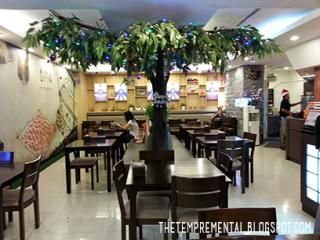
The moment you step in and comfortably settle into your seat, the retail lot radiates the feel of a Korean home, welcoming you with open arms. The tidbits are sold at one corner of the restaurant behind the cashier while the Korean ornaments are displayed in a built-in wooden shelf at the back of the restaurant, never failing to attract the attention of curious diners. In the middle of the restaurant lies a life-sized tree with curving branches and acting as a divider between the two double sided seat sofas is a row of potted greenery; some with flowers, some mere plants.
It may be a little retail outlet hidden from public view but the restaurant can be sardine-packed with employees from the neighboring offices such as Nestle, hungry for something so satiating that they can survive the remaining working hours without the need to reach out for finger food. What I like about Oiso is that it harbors a complacent snug that resembles a well-behaved bug in a rug - or at least during our visit. It actually allowed us to enjoy the dishes that we ordered and savor each bite/spoonful in a relaxed manner. I'm a sensitive diner, so when the distractions in the restaurants grow louder with the inclusion of loud chatters, I tend to desire to finish my portion faster than normal and bolt from the place after payment soonest possible.
Seating space here, unfortunately, is rather limited; you can find yourself queuing for a vacant table during the peak lunch hour.

The items for a decorative display
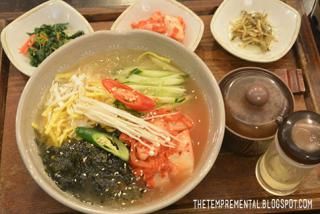
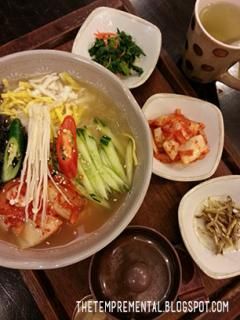
Kimchi Soup Noodle (Cold Noodle) (RM 13.90) consists of enoki mushroom, sliced cucumbers, seaweed flakes, sliced egg yolk and white, kim chi, noodles
To be honest, I was more than apprehensive when I perused the menu as I've never tasted more than half of the dishes printed on the booklet and certainly didn't want to ruin the dining experience by ordering an item that I'm not comfortable with. Sensing my hesitation, Mr. Jung recommended that I order the Kim Chi Soup Noodle as it's a summer dish and a hot favorite among diners.
My jaw was gaping wide when the waiter delivered the dish as the portion was enormous. Although the stock was ice-cold, it contained a rejuvenating twist that soothed and satiated the thirst. The cucumber slices were a refreshing contrast to the kim chi, the cool comfort seeping into the soap and balancing the spicy flavor produced. The seaweed flakes provided a soft twinge of salt, not sweetening the Kim Chi Soup Noodle or making it saltier either. The aftertaste was in the middle of the food spectrum. The mushroom however leaned towards being uncooked. I was crammed with the lavish amount of condiments, especially the soup that satiated the hunger with ease.
If you're not famished, I'd recommend you to share this dish with a fellow food companion.
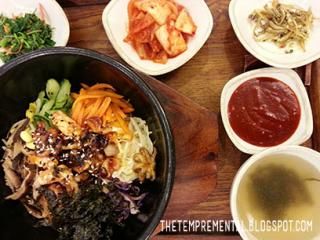
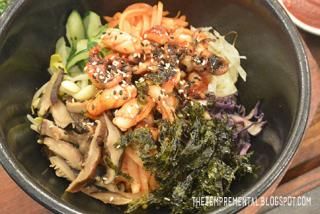
[Seafood] Bibimbap (RM 15.90) contains carrots, mushrooms, purple + white cabbage, cucumber, seaweed flakes, rice, baby octopus and baby squid
It is extremely common to associate bibimbap with Korean cuisine due to its popularity worldwide, but to find authentic ones can be like finding a needle in a haystack. It is a historical dish, originating from the city of Jeonju in the 19th century as a way of harmoniously blending the ingredients into one dish before seasoning it with only chili pepper paste and, on rare occasions, a salty soybean paste to even out the tang. Bibimbap is kind of similar to Chinese mixed rice, or more commonly known as chap fan in Cantonese.
Mama Carrie adores this dish so much that she practically finished 3/4 of the portion in the silence, leaving only 1/4 for me to sample. She felt that not only was there a generous amount of elements that left a lingering but satisfying zest to the palate, it contained traces of a Korean mother's traditional cooking.
She added that the flavors of each ingredient didn't attempt to override each other or compete to stand out, retaining its distinctive attraction instead. The sliced mushroom was blanched, omitting the use of salted water whereas the small squids were chewy but not rubbery. The carrots, on the other hand, were extremely juicy and produced the natural glucose that it is known for.
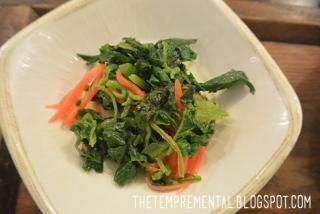
Chopped Spinach and Carrot Slices

Kim Chi: fermented cabbage with pear slices and rich in vitamins A and C but high in sodium

Chili Sauce
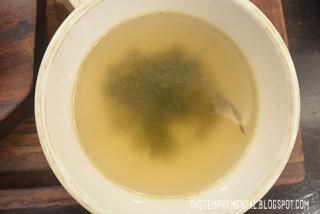
Korean Miso with Seaweed
The bibimbap was flavorsome and nutritious yet healthy with no MSG being added to heighten the flavor. It exposed her taste buds to a variety of aroma - with the aftertaste lifting you to culinary haven.
We desire to return for a second serving in the future as she has fallen in love with this dish. She believes that this is the best one so far as our first try was at Food Republic Pavilion KL and the second was in Westfield Carousel's food court, Cannington, WA.
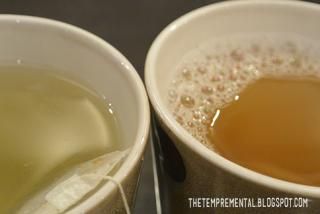
Korean Green Tea + Korean Organic Brown Tea
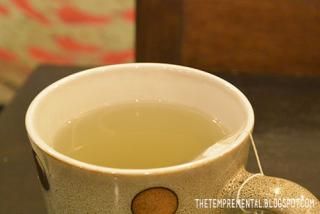
Korean Green Tea (RM 2.90) has a mellow scent to it and does not overpower the olfactory system either. Unlike certain types of tea, this drink is instead soft on the palate and digestive system.
The flavor does not subside, be it served hot or cold.

Korean Organic Brown Tea (RM 1.90), on the contrary, has an immense roasted flavor that surprisingly glides down the throat with ease, not leaving an awkward aftertaste on the palate.
The aroma evokes the afterthought of brown rice tea.
Special Promotion: For diners who quote the code OISO10, they will receive a 10% discount off their total bill.
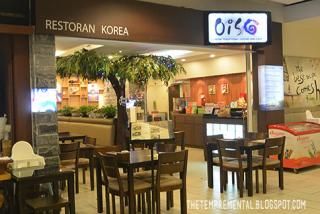
Name: Oiso Korean Traditional Cuisine and Café,
Lot LG19 and 20, Lower Ground Floor,
IPC Shopping Centre,
No.2, Jalan PJU 7/2,
Mutiara Damansara,
47800 Petaling Jaya,
Selangor
Landmark: It is directly opposite Pos Malaysia.
Lovely! Hope to check it out if I hop over to KL. We have ONE supposed to be Korean place here, food is ok but I would not say it is all that authentic apart from the fact that there's kimchi. :(
ReplyDeleteYou really should, suituapui. =) For me, if the owner and chef are both Koreans, it should be authentic because they grew up with the quintessential flavor of the cuisine. ^^
DeleteOohh...is at IPC. Although I don't fancy Korean food but your photos make me really want to try it out.
ReplyDeleteMerry Christmas to you and family.
Yup, at IPC. Should be pretty near to KD. =) Neither am I a huge fan of Korean food, Yee Ling.... but there are specific dishes that I savor, like the bibimbap and kim chi. ^^ Do give it a try and let me know how it goes, yeah? =)
DeleteThat kimchi soup noodle has clear soup. And cold noodles? This is unexpected, I have never seen this in so many of the Korean restaurants here. I wonder when I can head over and try it out..
ReplyDeleteYup, cold noodles, CL. ^^ Well, I think it is because it's not so popular among the Malaysian diners? I didn't know until I saw a Korean acquaintance having it for lunch once; she explained that it's to quell the melting summer back home hence the cold broth. Hmm, maybe when you're back in KL for a longer time?
Delete